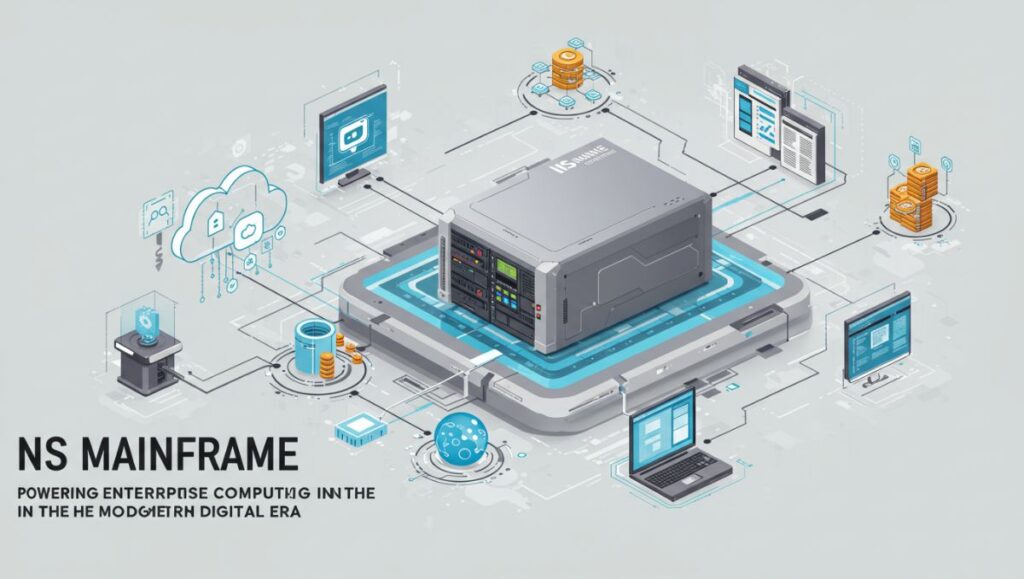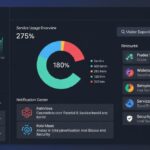In today’s fast-paced digital world, where businesses demand constant uptime, lightning-fast processing, and data security, mainframes continue to serve as the backbone of large-scale enterprise operations.
Among the leading solutions in this space, NS Mainframe has established itself as a powerful, secure, and scalable computing platform designed to meet the complex demands of financial institutions, government agencies, and global corporations.
Built on decades of innovation and refined architecture, NS Mainframe stands as a testament to reliability and high-performance computing — ensuring that mission-critical applications remain efficient, secure, and always available.
What Is NS Mainframe?
NS Mainframe is a next-generation mainframe computing system developed to handle vast amounts of data, complex transaction processing, and enterprise-level workloads.
The “NS” stands for Network Systems, reflecting its deep integration with modern network infrastructures and distributed computing environments.
Unlike traditional server setups, a mainframe like NS is engineered for massive input/output (I/O) operations, fault tolerance, and parallel data processing, making it ideal for organizations that cannot afford downtime or data loss.
Its use cases range from banking and insurance systems to healthcare databases, transportation logistics, and government data centers.
The Evolution of Mainframe Computing
Mainframes have existed since the mid-20th century, serving as the core of business computing long before cloud computing or distributed databases became mainstream.
While many predicted the decline of mainframes in the era of personal computers, the opposite has happened. Modern platforms like NS Mainframe have evolved to integrate with hybrid cloud environments, support modern programming languages, and offer API-based connectivity.
NS Mainframe represents this evolution — blending the legacy stability of mainframe architecture with the flexibility of modern software ecosystems.
Key Features of NS Mainframe
NS Mainframe is designed to deliver reliability, scalability, and security on an enterprise scale. Below are its defining features and advantages:
1. High-Performance Processing
At its core, NS Mainframe offers massively parallel processing capabilities. It can handle millions of transactions per second, ensuring smooth operations for industries like banking and e-commerce, where real-time processing is crucial.
2. Scalability and Virtualization
One of the standout aspects of NS Mainframe is its ability to scale seamlessly. Organizations can run thousands of virtualized environments (LPARs) on a single machine, optimizing hardware usage and cost efficiency.
3. Unmatched Reliability
Mainframes are known for their 99.999% uptime — and NS Mainframe upholds that standard. Its fault-tolerant hardware and automatic failover mechanisms make it one of the most reliable platforms available.
4. Enhanced Security and Compliance
With cybersecurity threats on the rise, NS Mainframe integrates advanced encryption, access control, and compliance management tools to meet global data protection standards like GDPR, HIPAA, and ISO/IEC 27001.
5. Hybrid Cloud Integration
Unlike traditional systems, NS Mainframe can operate in hybrid environments, allowing organizations to connect on-premise infrastructure with cloud-based applications.
6. AI and Machine Learning Integration
Newer versions of NS Mainframe include AI-enhanced data analytics tools that allow enterprises to process and interpret large datasets in real time, enhancing decision-making capabilities.
Architecture and Technical Design
1. Centralized Core Architecture
The heart of NS Mainframe lies in its centralized architecture, designed to handle multiple workloads simultaneously while maintaining stability and speed.
2. Multi-Layer Processing Model
It uses a multi-layer architecture, separating application logic, data management, and network communication, which ensures better efficiency and easier maintenance.
3. Support for Modern Languages
While mainframes traditionally used COBOL or Assembler, NS Mainframe supports modern programming languages like Java, Python, C++, and Go, making it adaptable for modern developers.
4. Advanced Storage Systems
NS Mainframe uses hierarchical storage management (HSM) to balance between high-speed SSDs and large-capacity magnetic drives, ensuring both speed and cost-efficiency.
5. Virtualization and Container Support
The platform supports virtual machines (VMs) and containerized applications, allowing organizations to deploy microservices within mainframe environments.
Why Organizations Still Rely on NS Mainframe
Despite the rise of cloud computing and distributed servers, mainframes remain indispensable in specific industries. NS Mainframe continues to dominate in sectors that require absolute reliability, speed, and security.
1. Banking and Financial Services
Over 70% of global banking transactions run on mainframes. NS Mainframe’s transaction management system ensures instant fund transfers, fraud detection, and real-time reconciliation across millions of accounts.
2. Government and Defense
Public sector entities rely on Mainframe for data protection, national ID systems, and secure communication networks.
3. Healthcare Systems
Hospitals and insurance companies depend on NS Mainframe for electronic health records (EHR) and medical claims processing, where uptime and data integrity are vital.
4. Retail and Supply Chain Management
Global retailers use NS Mainframe to manage inventory, logistics, and customer transactions at scale.
5. Telecommunications
Telecom companies leverage NS Mainframe for billing, customer support, and infrastructure monitoring, handling millions of interactions per second.
Integration with Modern IT Ecosystems
NS Mainframe doesn’t exist in isolation. Its greatest strength is its compatibility with modern IT architectures, including:
-
Cloud services like AWS, Azure, and Google Cloud.
-
APIs and RESTful interfaces for app connectivity.
-
Database integration with SQL, NoSQL, and distributed ledger systems.
-
DevOps pipelines for automated deployment and monitoring.
This makes Mainframe an ideal backbone for digital transformation initiatives, ensuring that legacy systems remain relevant in the era of microservices and containerized apps.
Security Features of NS Mainframe
Cybersecurity is central to Mainframe’s design. With billions of dollars in sensitive transactions flowing through mainframes daily, data protection is non-negotiable.
1. Multi-Layer Encryption
Mainframe uses both data-at-rest and data-in-transit encryption to safeguard sensitive information.
2. Role-Based Access Control (RBAC)
Administrators can define granular access policies, ensuring only authorized personnel access specific datasets or processes.
3. Real-Time Threat Detection
Through AI-driven security analytics, Mainframe can detect anomalies and potential breaches before they escalate.
4. Compliance Auditing
Integrated compliance tools ensure that organizations meet mandatory legal and financial reporting standards.
These measures make Mainframe a trusted choice for industries handling critical data.
NS Mainframe vs. Cloud Computing
The debate between mainframes and cloud platforms is ongoing. However, Mainframe isn’t necessarily in competition with the cloud — it complements it.
| Feature | NS Mainframe | Cloud Platforms |
|---|---|---|
| Reliability | 99.999% uptime | Varies by provider |
| Scalability | Vertical & horizontal | Primarily horizontal |
| Security | On-premise encryption | Shared responsibility model |
| Latency | Extremely low | Dependent on internet speed |
| Cost Model | High initial investment | Subscription-based |
| Integration | Seamless with hybrid systems | API-based connections |
For organizations that need uninterrupted performance with cloud flexibility, a hybrid approach — combining NS Mainframe and cloud infrastructure — offers the best of both worlds.
The Role of NS Mainframe in Digital Transformation
As businesses embrace automation, analytics, and AI, Mainframe provides a stable, scalable foundation for modernization.
1. API-Driven Innovation
APIs allow developers to extend mainframe capabilities into modern web and mobile applications.
2. Data Analytics and AI Integration
By processing massive datasets quickly, Mainframe supports real-time analytics, enabling businesses to make faster, smarter decisions.
3. Legacy System Modernization
Rather than replacing decades-old systems, organizations can re-platform them onto the Mainframe for improved performance and longevity.
In this way, Mainframe bridges the gap between legacy reliability and modern agility.
Environmental and Cost Efficiency
Modern Mainframes are designed with energy efficiency in mind. They consume significantly less power per transaction compared to large server farms.
Additionally, by consolidating workloads on fewer machines, organizations reduce hardware costs and minimize their carbon footprint — a growing priority in today’s ESG-conscious business world.
Future Outlook: Where NS Mainframe Is Heading
The future of mainframes is far from over — in fact, it’s expanding. Mainframe is expected to:
-
Adopt more AI-driven automation for self-optimization.
-
Enhance quantum computing compatibility for advanced research.
-
Offer full container orchestration for DevOps pipelines.
-
Integrate zero-trust security architectures to prevent data breaches.
As industries continue to digitize and interconnect, the Mainframe will remain a core infrastructure component — evolving to support ever-growing global data demands.
Conclusion
In an age defined by cloud computing and decentralization, Mainframe reminds us that stability, speed, and reliability remain essential pillars of enterprise IT.
Its unmatched processing power, airtight security, and modern integration capabilities make it a critical tool for organizations that cannot afford downtime or data loss.
Rather than being replaced by the cloud, the Mainframe has found its place within it — powering digital transformation from the core.
For large enterprises seeking resilience, performance, and long-term value, Mainframe stands as a trusted foundation for the future of computing.






